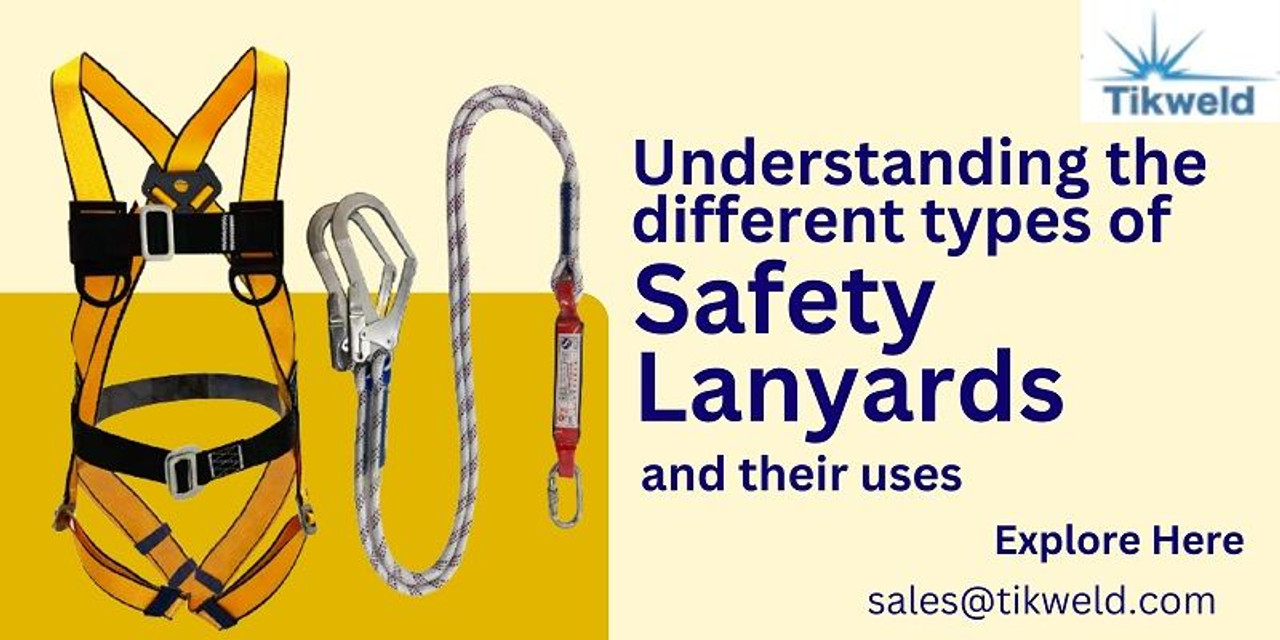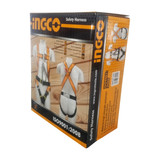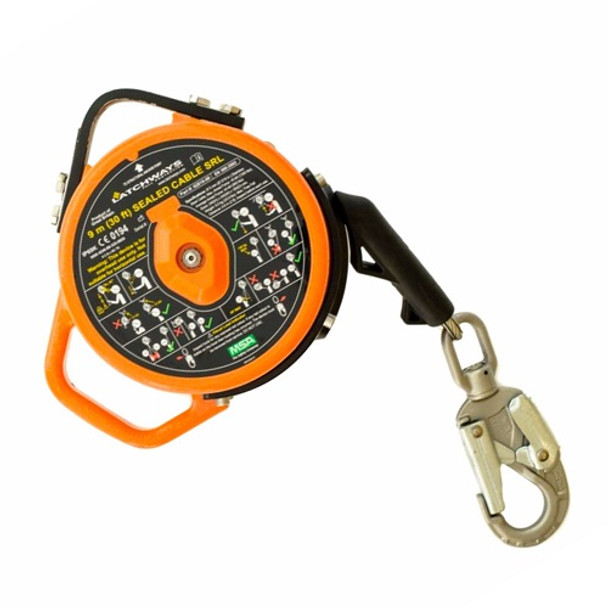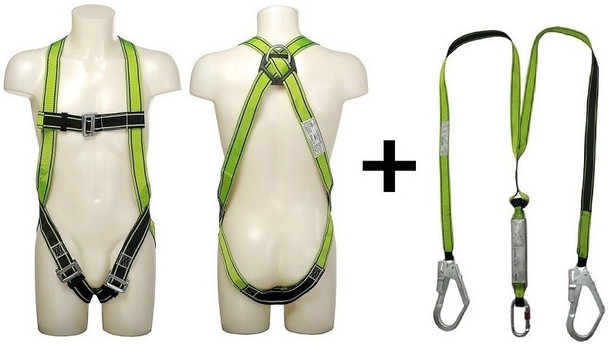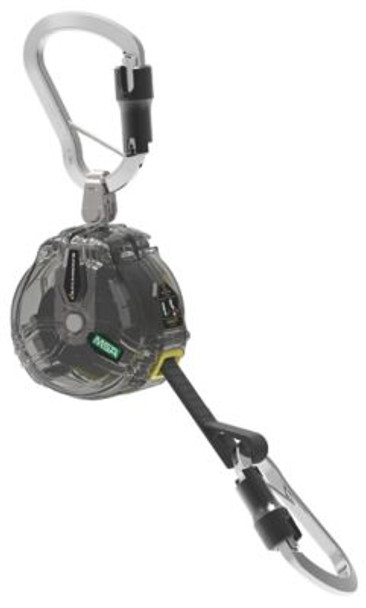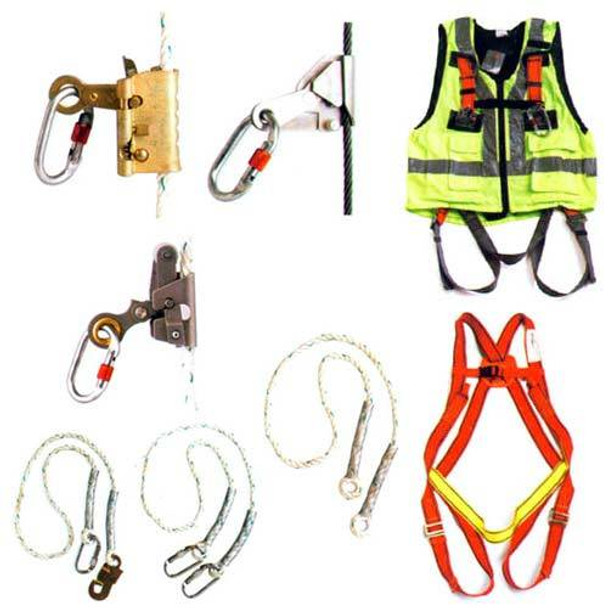Understanding the different types of safety Lanyards and their uses
Introduction
Working at heights can be dangerous, so safety lanyards are an essential piece of personal protective equipment (PPE) for workers. Safety lanyards are designed to secure a worker to an anchor point, preventing falls and reducing the risk of injury. However, with different types of lanyards available, it can take time to determine which type is best for a specific job. This article will explore the various types of safety lanyards available, including positioning lanyards, shock-absorbing lanyards, restraint lanyards, retractable lanyards, and tie-back lanyards, and adequately classify them based on their specific design and intended use. By understanding the different types of safety lanyards, their classification, and their intended use, employers and workers can ensure that they select the appropriate kind of lanyard for their specific job requirements, ultimately promoting a safe working environment.
Buy Online... Ingco Safety Harness Full Body Protection Kit 50mm HSH501502
Key Takeaway
- Safety lanyards are critical components of fall protection systems, designed to secure workers at heights by connecting their harness to an anchor point and minimizing fall-related injuries.
- There are several types of safety lanyards, including shock-absorbing lanyards, retractable lanyards (SRLs), positioning lanyards, and restraint lanyards, each tailored to specific tasks and risk levels.
- Shock-absorbing lanyards are best suited for arresting falls, as they reduce the impact force by gradually decelerating a falling worker, making them ideal for high-elevation jobs.
- Retractable lanyards (SRLs) offer greater mobility and less slack, automatically adjusting to a worker’s movement and locking instantly during a fall, suitable for dynamic environments like construction or telecom work.
There are two types of safety lanyards: positioning lanyards and shock-absorbing lanyards.
Positioning lanyards are designed to control workers' movement within a specific work area while preventing them from entering a fall hazard zone. They are not intended to arrest a fall but to maintain a worker's position.
Shock-absorbing lanyards, on the other hand, are designed to limit the amount of force transferred to a worker's body in the event of a fall. They feature an energy-absorbing unit that deploys to absorb the energy of a fall, reducing the force transferred to the worker's body.
Other types of Safety lanyards
There are two main types of lanyards: positioning lanyards and shock-absorbing lanyards.
In addition to these two main types of lanyards, other types are available that are designed for specific applications. For example:
- Restraint lanyards: These are intended to prevent workers from reaching a fall hazard zone by restraining their movement. They are commonly used when a worker needs to be prevented from approaching an edge or other hazard.
- Retractable lanyards: These use a spring-loaded mechanism to retract the lifeline and arrest a fall automatically. They are typically used in situations where the worker needs to move freely and are commonly used when the distance of free fall is less than two feet.
- Tie-back lanyards: These are designed to anchor the worker to a structure not specifically designed for fall protection. They are commonly used when an anchor point is not readily available or when a worker needs to be anchored to a specific point.
Buy Online... Latchways Sealed Self-Retracting Lanyards MSA
Classifying the other types of Lanyards
Restraint lanyards, retractable lanyards, and tie-back lanyards can belong to either the positioning lanyard or shock-absorbing lanyard categories, depending on their specific design and application.
Restraint lanyards are typically positioning lanyards because they are designed to prevent a worker from reaching a fall hazard zone by restraining their movement. They are not intended to arrest a fall but to maintain a worker's position.
Depending on their specific design, retractable lanyards can belong to either positioning lanyards or shock-absorbing lanyards. Retractable lanyards with a braking system are shock-absorbing lanyards designed to arrest a fall. Those without a braking system are positioning lanyards because they are designed to control a worker's movement within a specific work area.
Tie-back lanyards can also belong to either category, depending on their design. Some tie-back lanyards are designed to be used as positioning lanyards, while others are intended as shock-absorbing lanyards.
Ultimately, the classification of these lanyards depends on their specific design and intended use. It is essential to carefully evaluate the specific job requirements and select the appropriate type of lanyard to ensure worker safety.
It is essential to select the appropriate type of lanyard based on the specific job requirements to ensure worker safety.
Buy Online... Safety Harness Lanyard D/b MFK Vaultex
Comparison Table: Types of Safety Lanyards and Their Applications
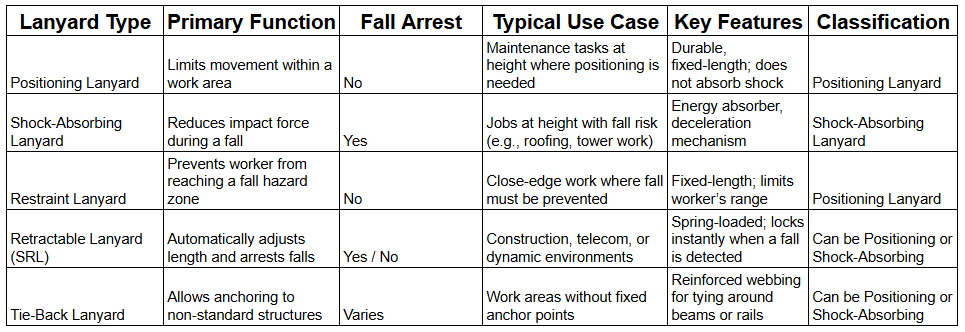
Understanding the difference between self-absorbing lanyards and self-retracting lanyards
Shock-absorbing and self-retracting lanyards are different, although they both serve as fall protection equipment. Shock-absorbing lanyards are designed to limit the force transferred to a worker's body in the event of a fall. They feature an energy-absorbing unit that deploys to absorb the energy of a fall, reducing the force that is transferred to the worker's body. They typically have a maximum arrest force that the manufacturer specifies, and they are commonly used when the distance of free fall is more than two feet.
Self-retracting lanyards, also known as retractable lanyards, use a spring-loaded mechanism to retract the lifeline and arrest a fall automatically. The mechanism includes a braking system that stops the fall by friction, absorbing the energy generated by the fall. They are typically used when the worker needs to move freely, and they are commonly used when the free fall distance is less than two feet.
While shock-absorbing and self-retracting lanyards are designed to protect workers from falls, they are used in different circumstances and have different mechanisms for arresting a fall. Selecting the appropriate type of fall protection equipment based on the specific job requirements is important to ensure worker safety.
Determining which type of lanyard is appropriate depends on various factors, including the height of the work, the equipment used, and the work environment. It is essential to carefully evaluate the specific job requirements and select the appropriate type of safety lanyard to ensure worker safety.
Lanyards are used to secure a worker to an anchor point, preventing falls and reducing the risk of injury. When it comes to working at heights, safety lanyards are an essential piece of personal protective equipment (PPE). Two different types of lanyards are available: positioning lanyards and shock-absorbing lanyards.
Learn more about how to Prevent Accidents with Self-Protecting Safety Lanyards
Buy Online... V-TEC Personal Fall Limiter MSA
Positioning Lanyards
Positioning lanyards control a worker's movement within a specific work area. They are typically used when a worker needs to maintain a particular position, such as when performing tasks requiring both hands. Positioning lanyards are not designed to arrest a fall but rather to prevent a worker from entering a fall hazard zone.
Positioning lanyards are typically made of a strong, durable material such as nylon or polyester and feature a hook or carabiner at one end that attaches to the worker's harness or safety belt and a loop or another attachment mechanism at the other end that connects to the anchor point. They are designed to limit the amount of movement a worker can make and keep them safely positioned.
Shock Absorbing Lanyards
Shock-absorbing lanyards are designed to limit the force of a fall if a fall occurs. They feature an energy-absorbing unit that deploys to absorb the energy of a fall, reducing the force transferred to the worker's body.
Shock-absorbing lanyards are typically made of a robust and durable material such as nylon or polyester, and feature a hook or carabiner at one end that attaches to the worker's harness or safety belt and a loop or another attachment mechanism at the other end that connects to the anchor point. The energy-absorbing unit is typically located near the attachment point on the lanyard and deploys when a fall occurs.
Buy Online... Harness Fall Protection Equipment Karam
Which Lanyard is Right for You?
Determining which type of lanyard is suitable for a specific job depends on various factors, including the height of the work, the kind of equipment being used, and the work environment. Positioning lanyards are used when a worker needs to maintain a specific position. In contrast, shock-absorbing lanyards are used when a fall hazard exists and the worker needs protection in the event of a fall.
It's important to note that OSHA requires employers to provide fall protection to workers at six feet or more. This means that both positioning and shock-absorbing lanyards may be necessary depending on the job and work environment.
In conclusion, safety lanyards are a critical component of PPE for workers who perform tasks at height. Positioning lanyards control a worker's movement within a specific work area. In contrast, shock-absorbing lanyards are used to limit fall arrest forces in the event of a fall. Determining which type of lanyard is suitable for a specific job depends on various factors and should be carefully evaluated to ensure the safety of workers.
Frequently Asked Question
1. What is a safety lanyard?
A safety lanyard is a device used when working at height to connect a harness to a secure anchor point, helping to prevent the wearer from falling to the ground.
2. What is the OSHA standard for lanyards?
According to OSHA standards, a safety belt lanyard must be at least 1/2 inch in diameter if made of nylon or an equivalent material. It should be of a length that limits the potential fall to no more than 6 feet. Additionally, the lanyard must have a minimum breaking strength of 5,400 pounds.
3. What is the difference between Type 1 and Type 2 lanyards?
Type 1 lanyards deploy a 3.5 ft shock absorber when 500 lbs of force is applied and are used with anchor points at or above the harness D-ring. Type 2 lanyards are designed for foot-level anchors and offer greater shock absorption for increased fall distance.
4. Who wears lanyards?
Lanyards are worn by people who need visible identification, such as employees, security staff, hospital workers, inmates, and attendees at conventions, trade shows, or events like concerts and festivals.
5. How many types of lanyards are there?
There are three main types of lanyards: shock-absorbing lanyards, self-retracting lanyards (SRLs), and positioning lanyards.
Related Articles
Choosing the Right Fall Protection Lanyard: Types and Safety Tips
Conclusion
Understanding the different types of safety lanyards and their specific uses is vital for protecting workers in high-risk environments. From shock-absorbing lanyards that arrest falls to restraint lanyards that prevent access to hazardous areas, choosing the right equipment not only enhances safety but also ensures compliance with industry standards. Proper training, regular inspection, and investing in high-quality lanyards are essential steps in maintaining a secure and efficient worksite.
For reliable, certified, and industry-compliant safety lanyards and fall protection equipment, explore our wide range at Tikweld Welding Supplies. Equip your team with the best tools for the job—because safety is never optional.

